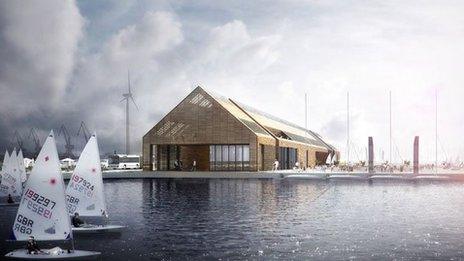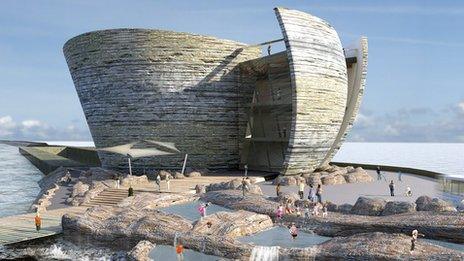Finance boost for £1bn Swansea Bay tidal lagoon
- Published
The project could generate 500GWH of electricity every year for more than a century, say developers
A £1bn plan for a tidal lagoon to generate power in Swansea Bay has been given a funding boost.
Investment management firm InfraRed Capital Partners has agreed to provide £100m for the project, BBC Wales understands.
The firm said its commitment means the scheme now has the full equity funding it needs to get going.
Developers say the project will harness tidal energy, which could power 155,000 homes for 120 years.
The news comes after financial services company Prudential agreed to invest £100m in the scheme last October.
The project is expected to generate 500GWH of electricity every year for more than a century - enough to power nearly all the homes in Swansea and Neath Port Talbot.

An artist's impression of how the lagoon around Swansea Bay could look if given the go-ahead

Analysis - BBC Wales' environment correspondent Iolo ap Dafydd
There seems to be a momentum for the developers in terms of attracting finance, but there are lots of other concerns that need to be addressed before this tidal lagoon can be built.
The planning inspectorate has until the 10 March to decide if it recommends the project or not, then it will be passed over the secretary of state for energy Ed Davey and, with a general election looming in May, the minister will only have a few short weeks to make his decision, unless of course the whole process is delayed until after the election and the possibility of a new government and a new minister.
Tidal Lagoon Power Ltd would love a decision to be made by Mr Davey before the election pending period and, as the first of its kind, the authorities have to consider the possible marine and environmental impact of building a lagoon in the Swansea Bay.

It will help the UK meet its carbon reduction targets by saving more than 236,000 tonnes of carbon dioxide each year.
It also establishes a blueprint for a total of six UK lagoons that could together provide 8% of the UK's electricity over 120 years, the company said.
If the plans are agreed, a six-mile-long U-shaped seawall would run from the docks to near Swansea University's new Fabian Way campus.
It would take two years to build and create 1,850 construction jobs.
Werner von Guionneau, chief executive of InfraRed Capital Partners, said: "The power station is unique in that it not only leverages the estuary's second highest tidal range in the world but it will also make a material contribution towards both the local economy in south Wales and the long term stability of sustainable energy supply in the UK."
The Planning Inspectorate is due to report its recommendations on the scheme in March and ministers must agree a price for the power generated by the lagoon before work can start.
- Published2 December 2014

- Published22 November 2014

- Published20 October 2014

- Published24 September 2014

- Published7 May 2014

- Published7 February 2014
